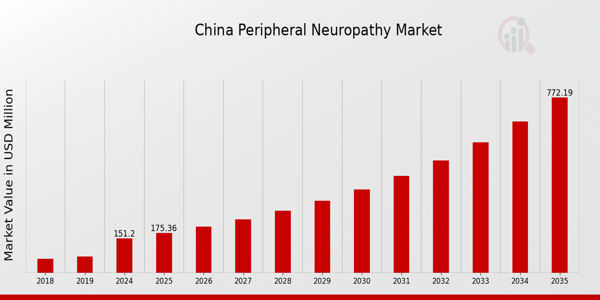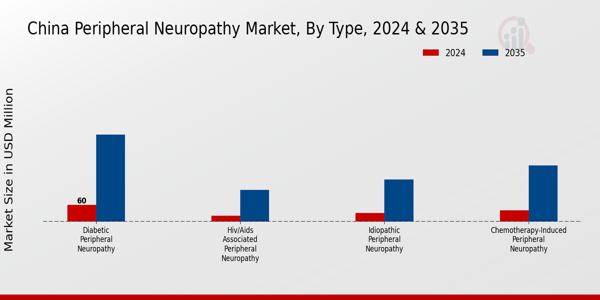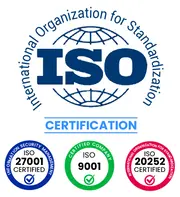China Peripheral Neuropathy Market Overview
As per MRFR analysis, the China Peripheral Neuropathy Market Size was estimated at 143.4 (USD Million) in 2023. The China Peripheral Neuropathy Market is expected to grow from 151.2 (USD Million) in 2024 to 772.2 (USD Million) by 2035. The China Peripheral Neuropathy Market CAGR (growth rate) is expected to be around 15.979% during the forecast period (2025 - 2035).
Key China Peripheral Neuropathy Market Trends Highlighted
The market for peripheral neuropathy is expanding significantly in China at the moment due to rising diabetes rates, which are a primary cause of neuropathy occurrences. Market dynamics are also significantly influenced by the government's initiatives to enhance healthcare quality and accessibility through a variety of measures.
Since peripheral nerve disorders are more common in older persons, China's ageing population increases the need for efficient neuropathy therapies. Furthermore, patients and healthcare professionals are becoming more aware of peripheral neuropathy, which improves patient outcomes by enabling earlier diagnosis and treatment.
By concentrating on research and development for novel treatments and technologies, opportunities in the China Peripheral Neuropathy Market might be seized. Combination therapies, which combine pharmaceutical and non-pharmacological methods to successfully control symptoms, are becoming increasingly popular as the market develops.
The country's great geographic diversity can be addressed by providing specialised care to patients in remote places thanks to the growth of telemedicine and digital health technologies. Recent developments in diagnostic methods and biomarker studies have led to new market trends since they make it easier to accurately identify and track neuropathy.
Better patient care and treatment procedures may result from this heightened emphasis on early detection. Pharmaceutical corporations and regional healthcare providers are increasingly collaborating, opening the door to more specialised treatment options for the Chinese population.
The market is at a turning point in its development, with several prospects for expansion being created by both evolving patient needs and technology breakthroughs.

Source: Primary Research, Secondary Research, Market Research Future Database and Analyst Review
China Peripheral Neuropathy Market Drivers
Increasing Prevalence of Diabetes and Related Neuropathies
China has witnessed a significant rise in diabetes cases over the past decade, with the International Diabetes Federation reporting that approximately 140 million adults in China were living with diabetes as of 2021. This increasing prevalence has led to a corresponding rise in peripheral neuropathy cases, which affects over 50% of diabetic patients.
The China Peripheral Neuropathy Market is poised to benefit as healthcare authorities, including the National Health Commission of the People's Republic of China, push for better management strategies and treatment options for diabetes, thus driving demand for neuropathy-related therapeutics and diagnostic tools.
The aim to improve treatment and management of diabetes is expected to further stimulate growth in the market, with healthcare investments focusing on enhancing patient care and innovative therapies to handle complications, including peripheral neuropathy.
Technological Advancements in Neuropathy Treatments
The China Peripheral Neuropathy Market is bolstered by technological advancements in the field of medicine and healthcare that have led to innovative treatment options, such as advanced drug formulations and minimally invasive surgical techniques.
With an increase in Research and Development (R&D) investment by major pharmaceutical companies and medical device manufacturers, new therapies and devices are being introduced rapidly. Reports indicate that the Chinese government is actively supporting biotech innovations through national funding initiatives and favorable regulatory changes aimed at facilitating the approval of novel therapies.
This push for innovation is expected to meet the growing demand for effective therapies in the management of peripheral neuropathies, thus fueling market growth in the coming years.
Aging Population and Related Health Issues
China's aging population is a significant market driver for the China Peripheral Neuropathy Market. According to the National Bureau of Statistics of China, the proportion of individuals aged 60 and above has been rapidly increasing and is projected to account for approximately 35% of the total population by 2050.
Older adults are more susceptible to various conditions, including peripheral neuropathy, leading to higher healthcare demands. The Chinese government has recognized these challenges and is focusing on developing geriatric care policies, which further highlights the need for specialized treatments and services to manage neuropathies effectively. This demographic shift is creating a sustained market demand for neuropathy solutions, significantly contributing to the market's overall growth.
Increase in Drug Approvals and Health Expenditure
The China Peripheral Neuropathy Market is experiencing growth as a result of an increase in drug approvals for neuropathy treatments and overall health expenditure in the region. The National Medical Products Administration (NMPA) in China has accelerated the drug approval process, enabling more manufacturers to bring new therapies to market.
With the Chinese government increasing its healthcare budget to support better patient outcomes, the market for peripheral neuropathy is being positively impacted. As a result, patients are gaining access to novel, effective treatments. The World Bank noted that China's health expenditure as a percentage of GDP was set to rise, demonstrating the government’s commitment to enhancing healthcare and treatment options, thereby driving the market forward.
China Peripheral Neuropathy Market Segment Insights
Peripheral Neuropathy Market Type Insights
The China Peripheral Neuropathy Market encompasses a diverse range of types, reflecting the multifaceted nature of this neurological condition. Among these, Diabetic Peripheral Neuropathy is the most prevalent form, primarily as a consequence of the increasing diabetes prevalence in China.
This segment is critical because it represents a significant portion of patients suffering from diabetes complications. As the population ages and lifestyle changes lead to higher diabetes rates, the demand for effective treatment and management options in this segment continues to grow.
Chemotherapy-induced Peripheral Neuropathy is another essential type, often overlooked, yet it represents a considerable challenge for cancer patients undergoing treatment. Many individuals experience neuropathic symptoms post-chemotherapy, which impedes their quality of life and can influence treatment adherence, making this area an active focus for therapeutic advancements.
Idiopathic Peripheral Neuropathy, while less understood, captures significant attention due to its unpredictable nature. This type poses a diagnostic challenge, as the causes remain unclear in many cases, leading to increased research investments focusing on identifying potential underlying mechanisms and treatments.
Lastly, the HIV/AIDS AIDS-associated peripheral Neuropathy type reflects the public health challenges due to the rise in HIV cases. This segment highlights an intersection of infectious disease management and neurological care, urging the healthcare system to develop integrated approaches to address peripheral neuropathies in immunocompromised patients.
Each of these types within the China Peripheral Neuropathy Market plays a significant role in shaping market growth, as they influence research and development efforts aimed at improving healthcare outcomes.
Understanding the nuances of these types allows for better-targeted interventions, educational initiatives, and support systems tailored to meet the needs of affected patients, thereby driving market dynamics and opening up pathways for innovation in treatment strategies.

Source: Primary Research, Secondary Research, Market Research Future Database and Analyst Review
Peripheral Neuropathy Market Treatment Insights
The Treatment segment of the China Peripheral Neuropathy Market encompasses various approaches aimed at managing this neurological condition, which affects millions in the region. Pharmacological Therapies play a crucial role in alleviating symptoms, providing pain relief and improving quality of life for patients.
This approach often includes analgesics, anticonvulsants, and antidepressants, each addressing specific neuropathic pain mechanisms. Non-pharmacological therapies, including physical therapy, acupuncture, and lifestyle modifications, are gaining traction due to their holistic benefits and fewer side effects, appealing to a growing segment of health-conscious individuals.
This trend reflects a shift towards comprehensive care models in China’s healthcare system. Additionally, the 'Others' category incorporates innovative treatments such as gene therapy and neuromodulation techniques, which are still in development but hold significant potential for future market expansion.
As the general population ages and conditions like diabetes and vitamin deficiencies rise, the demand for effective and varied treatment options is expected to grow significantly, driving market dynamics.
Overall, the Treatment segment is fundamental to forming a robust approach for managing peripheral neuropathy effectively in China, highlighting its pivotal role in patient health management amidst evolving therapeutic landscapes.
Peripheral Neuropathy Market End-user Insights
The China Peripheral Neuropathy Market is significantly influenced by various End-user categories, which include Hospitals and Clinics, Ambulatory Centers, and Others. Hospitals and Clinics represent a dominant portion of the market, reflecting a high demand for diagnosis and treatment of peripheral neuropathy, important due to the rise in diabetes and other chronic conditions.
The infrastructure available in these facilities allows for comprehensive patient care, which is crucial for effectively managing neuropathic symptoms. Ambulatory Centers have emerged as vital players as well, offering outpatient services that enhance patient convenience and reduce hospital stays.
This growth is driven by a shift towards minimally invasive procedures and patient-centric care models. Additionally, the 'Others' category, encompassing specialized treatment facilities and home care services, caters to the needs of patients requiring ongoing care and management.
These diverse End-user segments collectively contribute to an enriched patient experience and improved access to necessary treatments, ensuring comprehensive care within the China Peripheral Neuropathy Market landscape.
China Peripheral Neuropathy Market Key Players and Competitive Insights
The China Peripheral Neuropathy Market is characterized by a dynamic competitive landscape that reflects the growing demand for effective treatments targeting this condition.
As peripheral neuropathy affects millions of individuals in China, characterized by symptoms such as pain, numbness, and weakness often arising from diabetes or chemotherapy, pharmaceutical companies are increasingly focusing on developing specialized products.
The market is shaped by several key players that engage in rigorous research and development efforts, strategic partnerships, and innovative marketing strategies to capture a significant share. With advances in technology and growing awareness of peripheral neuropathy, the competitive environment is set to evolve further, presenting opportunities and challenges for existing and new entrants.
Teva Pharmaceutical has established a robust presence in the China Peripheral Neuropathy Market by leveraging its extensive portfolio of neurological products and therapies. The company is recognized for its strengths in generics and specialty pharmaceuticals, allowing it to offer cost-effective solutions for patients dealing with peripheral neuropathy.
Teva's commitment to research and development has resulted in a range of innovative medications that address the complex needs of this patient demographic. Its distribution network in China enhances its market penetration, while collaborations with local healthcare providers bolster its reputation and accessibility.
Furthermore, Teva's focus on patient-centric approaches ensures that its offerings resonate well with healthcare professionals and patients alike, solidifying its competitive stance in this growing market.
Pfizer, a prominent name in the global pharmaceutical industry, also plays a significant role in the China Peripheral Neuropathy Market. The company has made notable strides with key products targeting neuropathy-related symptoms, showcasing a commitment to addressing unmet medical needs within the region.
Pfizer’s strengths lie in its broad research capabilities and extensive experience in developing leading-edge therapies, reinforced by strategic mergers and acquisitions that have expanded its product offerings.
With a focus on improving patient outcomes and advancing treatment options, Pfizer actively collaborates with healthcare institutions and stakeholders within China to enhance the awareness and management of peripheral neuropathy.
The company's established presence in the market, combined with a strong suite of innovative medications and a focus on patient education, positions Pfizer as a formidable competitor in the ongoing battle against this challenging condition.
Key Companies in the China Peripheral Neuropathy Market Include
- Teva Pharmaceutical
- Pfizer
- Boehringer Ingelheim
- Sandoz
- Mylan
- Amgen
- Merck & Co
- AstraZeneca
- Bristol-Myers Squibb
- GSK
- Eli Lilly
- Johnson & Johnson
- AbbVie
- Sanofi
- Novartis
China Peripheral Neuropathy Market Developments
Recent developments in the China Peripheral Neuropathy Market reflect significant activities from leading pharmaceutical companies such as Teva Pharmaceutical, Pfizer, and Merck and Co. The market has seen consistent growth driven by an increasing prevalence of diabetes-related complications, with the government implementing policies geared towards enhancing healthcare access and treatment options.
In September 2023, Teva Pharmaceutical announced a collaboration with local Chinese firms to broaden its product line targeting nerve pain treatments. Additionally, in July 2023, Pfizer launched a new formulation aimed at peripheral neuropathy, specifically designed to improve patient compliance and efficacy.
In terms of mergers and acquisitions, there have been noteworthy movements, with Mylan acquiring a smaller biotech firm specializing in neurology therapies in August 2023, enhancing its portfolio within the China market.
The sector is also seeing substantial investment in Research and Development as companies like AstraZeneca and Johnson and Johnson strive to innovate and expand their market share. Overall, these initiatives highlight a competitive yet rapidly evolving landscape in the China Peripheral Neuropathy Market that aligns with broader health policy objectives aimed at improving patient outcomes.
China Peripheral Neuropathy Market Segmentation Insights
Peripheral Neuropathy Market Type Outlook
- Diabetic Peripheral Neuropathy
- Chemotherapy-induced Peripheral Neuropathy
- Idiopathic Peripheral Neuropathy
- HIV/AIDS Associated Peripheral Neuropathy
Peripheral Neuropathy Market Treatment Outlook
- Pharmacological Therapies
- Non-Pharmacological Therapies
- Others
Peripheral Neuropathy Market End-user Outlook
- Hospitals and Clinics
- Ambulatory Centers
- Others
| Report Attribute/Metric Source: |
Details |
| MARKET SIZE 2023 |
143.4(USD Million) |
| MARKET SIZE 2024 |
151.2(USD Million) |
| MARKET SIZE 2035 |
772.2(USD Million) |
| COMPOUND ANNUAL GROWTH RATE (CAGR) |
15.979% (2025 - 2035) |
| REPORT COVERAGE |
Revenue Forecast, Competitive Landscape, Growth Factors, and Trends |
| BASE YEAR |
2024 |
| MARKET FORECAST PERIOD |
2025 - 2035 |
| HISTORICAL DATA |
2019 - 2024 |
| MARKET FORECAST UNITS |
USD Million |
| KEY COMPANIES PROFILED |
Teva Pharmaceutical, Pfizer, Boehringer Ingelheim, Sandoz, Mylan, Amgen, Merck & Co, AstraZeneca, BristolMyers Squibb, GSK, Eli Lilly, Johnson & Johnson, AbbVie, Sanofi, Novartis |
| SEGMENTS COVERED |
Type, Treatment, End User |
| KEY MARKET OPPORTUNITIES |
Rising diabetic population, Increased healthcare investments, Growing telemedicine adoption, Advancements in pain management therapies, Enhanced patient awareness initiatives |
| KEY MARKET DYNAMICS |
increasing prevalence of diabetes, rising geriatric population, advancements in treatment options, growing awareness and diagnosis, availability of dedicated healthcare facilities |
| COUNTRIES COVERED |
China |
Frequently Asked Questions (FAQ):
The China Peripheral Neuropathy Market is expected to be valued at 151.2 million USD in 2024.
By 2035, the China Peripheral Neuropathy Market is projected to reach a value of 772.2 million USD.
The market is expected to grow at a CAGR of 15.979% from 2025 to 2035.
By 2035, Diabetic Peripheral Neuropathy is expected to dominate with a market size of 310.0 million USD.
In 2024, the market value for Chemotherapy-induced Peripheral Neuropathy is estimated to be 40.0 million USD.
Major players include Teva Pharmaceutical, Pfizer, Boehringer Ingelheim, and Merck & Co among others.
The market size for Idiopathic Peripheral Neuropathy is expected to reach 150.0 million USD by 2035.
The HIV/AIDS Associated Peripheral Neuropathy segment is valued at 21.2 million USD in 2024.
The overall market for Peripheral Neuropathy is anticipated to experience significant growth at a CAGR of 15.979% during this forecast period.
Emerging trends in treatment and an increasing patient population present key growth opportunities in the market.
















